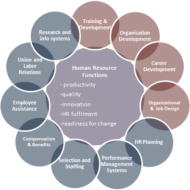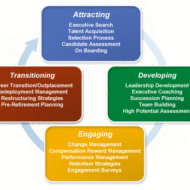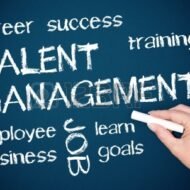Posted by Managementguru in Business Management, Human Resource, Organisational behaviour, Principles of Management
on Mar 17th, 2014 | 0 comments

Personnel or Human Resource Management: is the strategic approach to the management of an organization’s most valued assets – the people. Human resource is always in great demand as competent or skilled labor is in short supply. It is important to remember that no one is born with the value of excellence, as the acquisition is gradual in nature and only possible through proper training and one’s own cognitive perception. It is not that people have to belong to the elite group to make their mark in the respective fields. The best leaders and managers often are ordinary people creating amazing results and astounding success. Try some of these golden etiquettes for achieving excellence in the management of human resource: Clear objectives have to be set with the consensus of the employees Recognize the progress Confront problems Manage with flexibility Understand the value of quality Manage time for better results Enhance decision-making skills by delegating authority Master stress Motivate people Think like a winner Pursue a participative style of leadership To achieve the goals of the organization, the HR department will have to reorient itself on the following lines. It is very important that ‘Right people are chosen for the Right job’. During the induction stage, employee attitudes must be shaped in harmony with the culture of the organization. Dynamic training system should be introduced which is supposed to be a continuous process rather than a sporadic exercise. Quality of Work Life: Organization should ensure satisfactory quality of work life in order to minimize the sense of alienation, found in the workplace. It should contribute to an atmosphere to improve self-discipline, self-motivation and self realization for the purpose of production optimization in terms of both quantity and quality. The presence of a fair performance appraisal system will facilitate the growth prospects of employees in terms of career advancement and development. Fair Compensation: Institutions must work out a fair compensation package for all categories of workmen so that they may be able to receive the living wages instead of subsistence-level wages. The accent should be on production and productivity, without any compromise. Opportunities are aplenty, particularly for experienced personnel as the industries offer wide job prospects for the prospective candidates. Now-a-days job hopping is rampant which is a serious issue to be managed. A number of organizations offer bonus in the form of stock that interjects a feeling of oneness, which ensures alignment of interest between employees and the management. Favored position in terms of enhanced performance from the work force is possible only if the management comes down to embrace and lend their ears to certain rational demands form the other end. Security of Employment Increased wages Employee ownership Participation and employment Internal promotions Information sharing Incentives etc., The personnel function can 1) Attract attention to indicate the importance attached to management’s process and the various policies, practices and systems that support the process. 2) Provide necessary information and expertise on best practices in rival companies to benchmark the process and provide with analytical support for diagnosing and recounting solutions to problems arising in the employee management relation. 3) Engage in business decisions and accelerate change that is consistent with the underlying values of the company. Note: The laws and matters relating to wages and bonus come under the purview of the Ministry of Labor and Employment. The Minimum Wages Bill was passed by the Indian Dominion Legislature and came into force on 15th March,...

Posted by Managementguru in Business Management, Human Resource, Labor Management, Principles of Management
on Mar 10th, 2014 | 0 comments

Dimensions of Human Resource Management I would like to brief you on some of the key aspects that mark the paradigm shift in the HR environment towards better management prospects. 1. The Human Resource function has shifted its focus to a much wider canvas that includes Empowerment of EmployeesRestructuring the Organisation and so on. 2. A range of HR sub-systems are involved in Planning The NumbersTypes And Skills Of HrEnsuring Their AvailabilityPlacing In The Right JobPromoting And Nurturing Their Mental HealthHelping Them Develop Special Talent And Skills 3. Human Resource is considered as an “investment” and no more an “expenditure”. Investment in TrainingRe-Training AndContinuous Learning On The Job develops the skills and competences of managers and employees and prove to be an useful investment. 4. The concepts of Learning Organisations AndTeam-Building serves a basis for “Competitive advantage” and “Motivating the employees.” 5. Values that are stressed upon are Co-OperationHarmonisationSynergyTrustBeing Pro-ActiveCollaboration 6. Strategy: VisionMissionObjectivesGoals– How these can be achieved? The techniques that are basically holistic in nature can solve the purpose. Such techniques involve SEWA– Self mastery, Empathy for workers, Worker-directedness and Achievement in performanceABO-Action by Objective Nine Dimensions of an Effective HR Department: What is the reputation of the HR department?What are the criteria (deliverables) that shape HR work?What is the mission or strategy of the capabilities – focused HR department?How is the HR department organised? How does HR facilitate the definition and creation of organisation capabilities?How do we make better HR investment and choices?How do we create HR practices?How does HR go about doing its work? What do HR professionals need to be, know, and do to be effective? Let us make a sincere comparison between the past and the present in terms of HR perspective These techniques produce performers who find their way through any set of given problems, manage themselves and lead the team to a stae of self- realisation. Old model vs New model 1. Job was the basic unit/ Team is the basic unit 2. Relations with environment there handled by the individuals/ Densely networked with environment 3. Information flow was vertical/ now it is vertical, horizontal and holistic 4. Many layers of management / Organisations have become flat 5. Emphasis on structures/ Emphasis on process and literally virtual organisations have evolved 6. Career path upward and linear/ career path lateral and flexible 7. Standardised evaluation and reward system/ Customised evaluation and reward system 8. Ethnocentric/ International 9. Single strong culture/ Multicultural and diversity of viewpoints and...

Posted by Managementguru in Principles of Management, Training & Development
on Feb 22nd, 2014 | 0 comments

Benefits of Training to Employees Why training is needed for an Employee? Increases Confidence Training creates a feeling of confidence in the minds of employees, who feel comfortable while handling newer challenges. It gives a feeling of safety and security to them at the work place. New Skills Training develops skills, which serves as a valuable personal asset of a worker. It remains permanently with the worker himself. Career advancement The managers can develop their skills to take up higher challenges and work in newer job dimensions. Such an exercise leads to the career development of the employees, who can move up the corporate hierarchy faster. Higher Earnings Higher earnings are a consequence of career development. A highly trained employee can command high salary in the job market and feel more contended. Resilience to change In the fast changing times of today, training develops adaptability among workers. The employees feel motivated to work under newer circumstances and they do not feel threatened or resist any change. Such adaptability is essential for survival and growth of an organization in the present times. Increased Safety Trained workers handle the machines safely. They also know the use of various safely devices in the factory, thus, they are less prone to accidents. Use these popular and handy HR Quotes in your Blogs, Books, Journals, Presentations, Tweets, Facebook posts, Pinterest boards and Instagram posts. EVALUATION PHASE Training Evaluation Once you’ve implemented a training program based on careful needs analysis, how can you be sure that your training translates into real performance improvements? Evaluation can be used to determine whether the training program achieves its objectives. Evaluation can also assess the value of training, identify improvement areas, and identify unnecessary training that can be eliminated. Need for Evaluation Many training professionals agree that evaluation is important to successful training, but few conduct complete and thorough evaluations. Evaluation can seem anti-climatic to the excitement and creativity of creating a new course. Don Kirkpatrick’s 4 Levels of Evaluation One of the most widely used model for evaluating training programs is one that was proposed in 1959 by Donald L. Kirkpatrick. The model maintains that there are four levels to meas ure the quality or effectiveness of a training course. Don Kirkpatrick’s 4 levels of evaluation is the basis of discussion on evaluation of the effectiveness of training programs. Level 1 measures the learner’s reaction to the training program. Level 2 measures learning that has occurred. Level 3 measures changes in behavior on the job as a result of the training program. Level 4 measures the results of the training program as it affects the company’s bottom line. Each level has its advantages and disadvantages. It is important to plan the evaluation process, as the training is being planning. It is important to consider all levels at the outset, even though only one or two levels may be used ultimately. http://www.kirkpatrickpartners.com/OurPhilosophy/TheNewWorldKirkpatrickModel/tabid/303/Default.aspx Design of a Training Programme Some of the typical steps in designing a training programme are: Identification of training needs. Setting training objectives. Organizational set-up for training. Training operations. Evaluation of...






